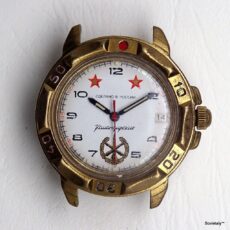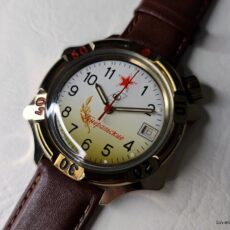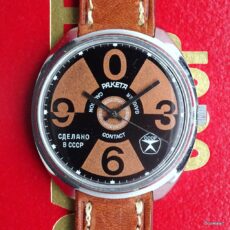Original title of the book: История часового завода Слава – В.Г. Богданов, 2002
Chapter 1: On the Measurement of Time in Russia
Description: The first chapter explores the origins of timekeeping in Russia, tracing back to the first tower clocks installed in Russian cities. It describes how these clocks were initially created by local craftsmen and gradually began to be imported from abroad. The narrative transitions from primitive timekeeping methods, such as sundials and water clocks, to the spread of mechanical clocks during the Middle Ages. It includes details about the first watch factories in Russia, established during the reign of Catherine II, and the challenges faced in maintaining stable and high-quality production.
Details:
- The first tower clock in Russia was installed in 1404 by a monk named Lazar Serbin.
- The Moscow watch factory, established in 1769, produced clocks often used as awards and official gifts.
- In the 16th century, mechanical clocks began to spread in churches and cathedrals, becoming symbols of prestige and advanced technology.
- The accuracy of clocks improved significantly due to advancements in astronomy and mechanics.
Chapter 2: The Need for a National Watch Industry
Description: This chapter highlights the crisis in the Russian watch industry during the World Wars and the revolution. With the interruption of imports and the closure of existing factories, the need to establish a national industry emerged. Efforts to reorganise existing resources and create new production facilities are described, along with attempts to import technology from abroad.
Details:
- In 1920, the Soviet Union created an agency dedicated to managing watch production, called the “Watch Agency”.
- During the 1920s and 1930s, the factory purchased machinery from the United States to initiate domestic watch production.
- Efforts to train skilled personnel were intensified, with the establishment of technical schools and training programmes.
Chapter 3: The History of the Second Moscow Watch Factory – 75 Years on the Market
Description: This chapter details the history of the Second Moscow Watch Factory (2MChZ) from its founding in 1924 to modern times. It describes the evolution of production technologies, the materials used, and the various challenges faced by workers during times of war and peace. The factory is depicted as a symbol of Soviet industrial innovation.
Details:
- The factory was initially founded as part of the Technical Military Department of the RKKA.
- In 1930, the factory began producing alarm clocks with components imported from Germany.
- The factory was a major supplier of watches for the Soviet army during World War II.
- In the 1950s and 1960s, the factory expanded and modernised, introducing new models and technologies.
Chapter 4: The Early Successes
Description: Describes the early years of the factory, focusing on efforts to increase production and improve the quality of watches. It details the technical and logistical difficulties faced, such as material shortages and the need to train new workers. The chapter includes testimonies from workers and managers who contributed to the company’s initial success.
Details:
- In 1930, the factory produced 144,000 alarm clocks and 628,000 wall clocks despite numerous initial difficulties.
- Factory managers implemented innovative production systems to increase efficiency.
- Staff training was a priority, with intensive on-the-job learning programmes.
- Production techniques relied on imported machinery and optimised processes for maximum efficiency.
Chapter 5: All for the Front, All for Victory
Description: During World War II, the factory’s production shifted towards military utility goods. The chapter describes the reorganisation of production and the factory’s significant contribution to Soviet war efforts. It highlights how the factory had to quickly adapt to new requirements, producing instruments and equipment for the army.
Details:
- The factory produced magnets for explosives and devices for parachute deployment.
- Despite wartime difficulties, the factory maintained constant high-quality production.
- Many factory workers were awarded for their contributions to the war effort.
- Watch production decreased, but technological innovation continued, preparing the ground for post-war recovery.
Chapter 6: Return to Civil Production
Description: The chapter describes the post-war period, during which the factory gradually returned to producing watches for civilian use. It includes details on the modernisation of facilities and the introduction of new technologies. It explores how the factory reinvented itself to meet new market demands.
Details:
- In the 1950s, the factory introduced the first Soviet chronometer, marking a significant advancement in precision and reliability.
- Production diversified to include wristwatches, wall clocks, and pocket watches.
- The factory became a symbol of economic revival and technological innovation.
- New production processes were implemented to improve quality and reduce costs.
Chapter 7: The Period of Decline
Description: Examines the years of economic difficulties and declining production faced by the factory during the late Soviet period and early post-Soviet years. Despite challenges, the factory continued to produce watches, maintaining a significant market share. Attempts at restructuring and modernisation to cope with new economic realities are discussed.
Details:
- In the late 1990s, the factory received congratulations from the President of Russia and the Mayor of Moscow for its 75th anniversary.
- It describes how the factory tried to adapt to global market changes.
- Efforts to maintain product quality and reliability were constant despite financial difficulties.
- Attempts to diversify production and develop new markets are explored.
Chapter 8: Conclusion and Appendices
Description: The conclusion summarises the achievements and challenges of the “Slava” watch factory. It includes a reflection on the historical importance of the factory and the future of the watch industry in Russia. The appendices offer additional technical details, production statistics, and a bibliography. Individual successes of workers and technological innovations introduced are also mentioned.
Details:
- An appendix section is dedicated to the individual successes of factory workers, many of whom received state awards for their contributions.
- Detailed production statistics and various models of watches produced are provided.
- The factory is presented as an example of resilience and innovation in the Russian industrial landscape.
- The appendices also include historical documents and photographs illustrating the factory’s evolution.



